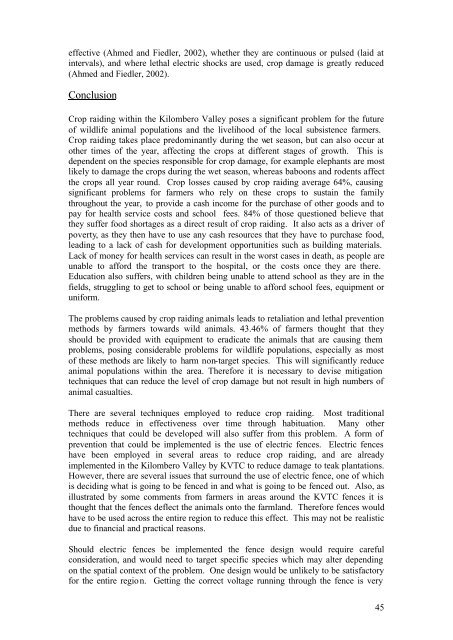Frontier Tanzania Environmental Research - Frontier-publications ...
Frontier Tanzania Environmental Research - Frontier-publications ...
Frontier Tanzania Environmental Research - Frontier-publications ...
You also want an ePaper? Increase the reach of your titles
YUMPU automatically turns print PDFs into web optimized ePapers that Google loves.
effective (Ahmed and Fiedler, 2002), whether they are continuous or pulsed (laid atintervals), and where lethal electric shocks are used, crop damage is greatly reduced(Ahmed and Fiedler, 2002).ConclusionCrop raiding within the Kilombero Valley poses a significant problem for the futureof wildlife animal populations and the livelihood of the local subsistence farmers.Crop raiding takes place predominantly during the wet season, but can also occur atother times of the year, affecting the crops at different stages of growth. This isdependent on the species responsible for crop damage, for example elephants are mostlikely to damage the crops during the wet season, whereas baboons and rodents affectthe crops all year round. Crop losses caused by crop raiding average 64%, causingsignificant problems for farmers who rely on these crops to sustain the familythroughout the year, to provide a cash income for the purchase of other goods and topay for health service costs and school fees. 84% of those questioned believe thatthey suffer food shortages as a direct result of crop raiding. It also acts as a driver ofpoverty, as they then have to use any cash resources that they have to purchase food,leading to a lack of cash for development opportunities such as building materials.Lack of money for health services can result in the worst cases in death, as people areunable to afford the transport to the hospital, or the costs once they are there.Education also suffers, with children being unable to attend school as they are in thefields, struggling to get to school or being unable to afford school fees, equipment oruniform.The problems caused by crop raiding animals leads to retaliation and lethal preventionmethods by farmers towards wild animals. 43.46% of farmers thought that theyshould be provided with equipment to eradicate the animals that are causing themproblems, posing considerable problems for wildlife populations, especially as mostof these methods are likely to harm non-target species. This will significantly reduceanimal populations within the area. Therefore it is necessary to devise mitigationtechniques that can reduce the level of crop damage but not result in high numbers ofanimal casualties.There are several techniques employed to reduce crop raiding. Most traditionalmethods reduce in effectiveness over time through habituation. Many othertechniques that could be developed will also suffer from this problem. A form ofprevention that could be implemented is the use of electric fences. Electric fenceshave been employed in several areas to reduce crop raiding, and are alreadyimplemented in the Kilombero Valley by KVTC to reduce damage to teak plantations.However, there are several issues that surround the use of electric fence, one of whichis deciding what is going to be fenced in and what is going to be fenced out. Also, asillustrated by some comments from farmers in areas around the KVTC fences it isthought that the fences deflect the animals onto the farmland. Therefore fences wouldhave to be used across the entire region to reduce this effect. This may not be realisticdue to financial and practical reasons.Should electric fences be implemented the fence design would require carefulconsideration, and would need to target specific species which may alter dependingon the spatial context of the problem. One design would be unlikely to be satisfactoryfor the entire region. Getting the correct voltage running through the fence is very45
















